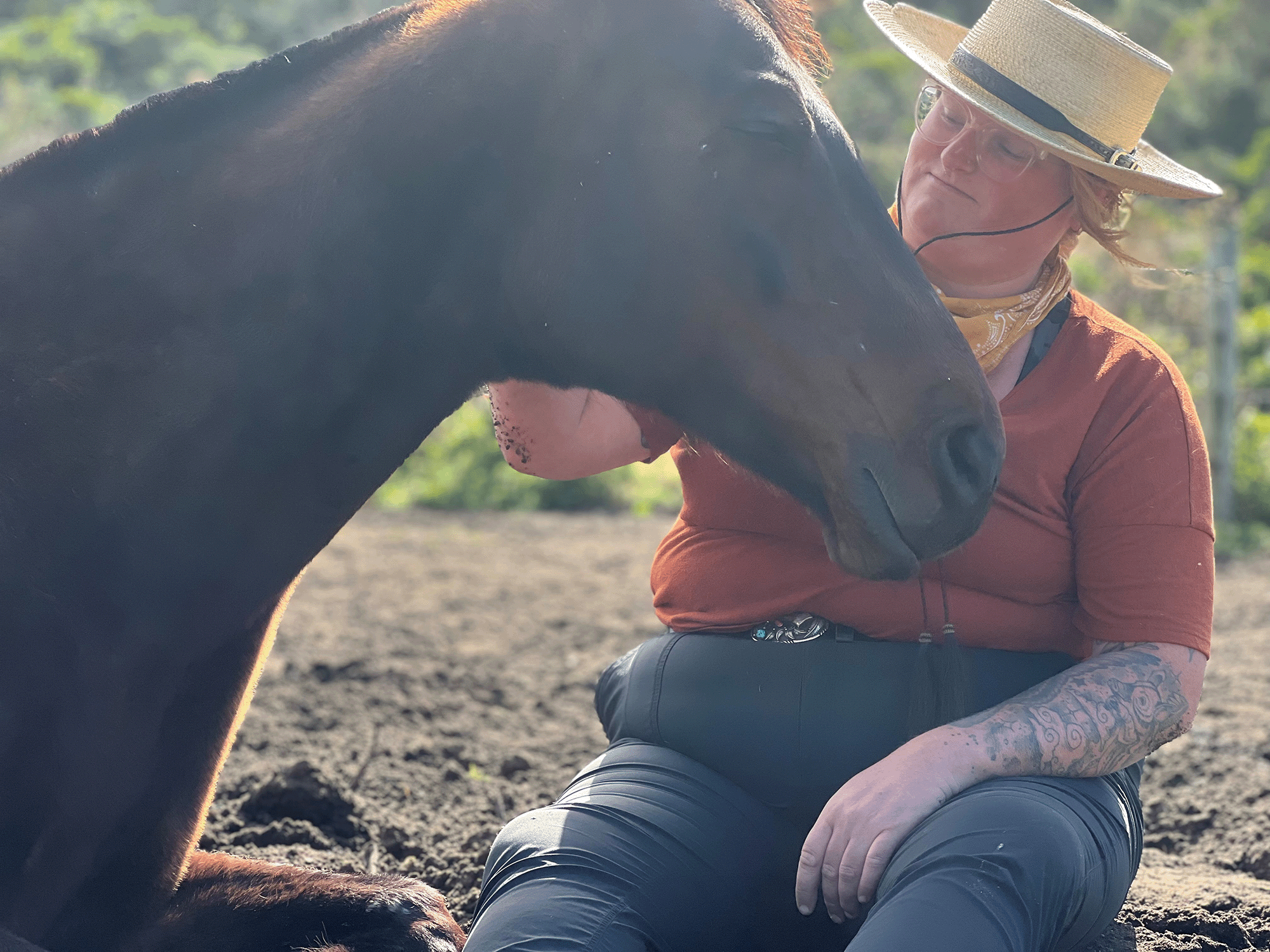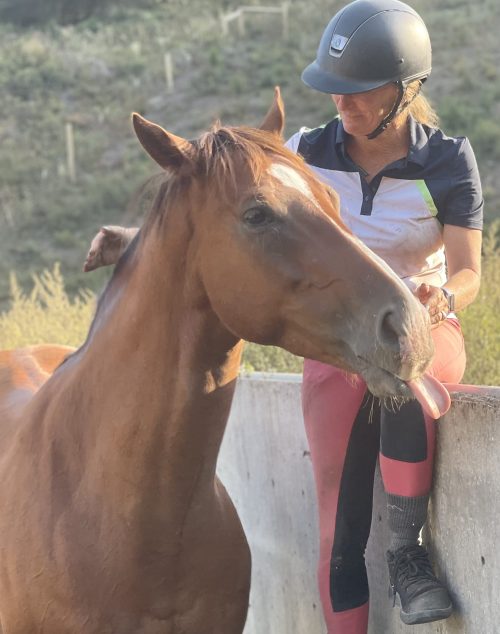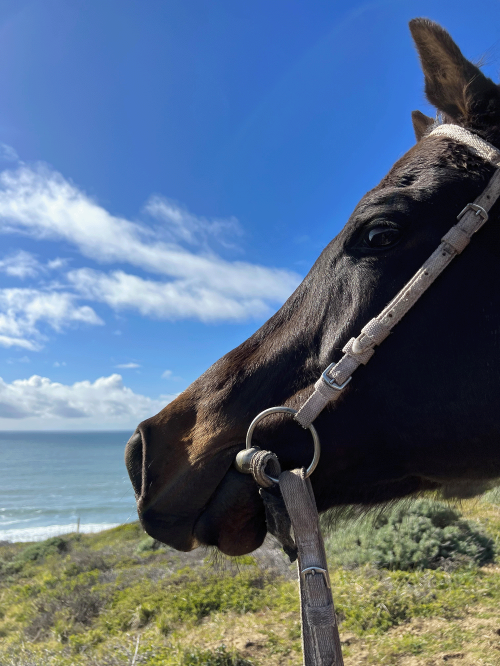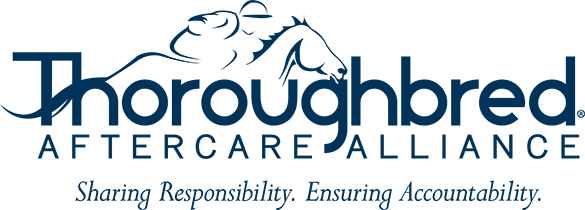
This article was originally featured in the October 2023 Issue of BloodHorse Magazine in the Second Acts series.
This article is the original format and text. To read the BloodHorse article or to subscribe click HERE.
Why an OTTB is an Excellent Therapy Horse
October 16, 2024
By: Joell Dunlap

There’s a lovely breeding farm in our quaint coastal California town of Half Moon Bay. The founder, a dear friend and colleague of mine, has every reason to take pride in her farm and the reputation earned for breeding successful show jumpers competing against European bloodlines. Recently, she called to offer me a gelding for our program. He’s young with a lovely temperament. However, it’s clear he won’t meet requirements for the International Jumper circuit. Rather than opting for a quick sale that might lead to unfavorable circumstances, the owners are determined to secure him a wonderful home.
I returned the call and thanked her for thinking of us. I took the opportunity to remind her the racing industry frequently provides us with numerous lovely geldings with pleasant temperaments. Unlike the showjumping industry, the racing industry remains supportive of our program and provides critical operating funds.
“But this gelding has three months training with a very good trainer,” my friend informed me. She is correct; the trainer is very good. She continued, “and he’s much further along than anything you would get fresh off the track.”
I’ve been sitting on that comment all day.
Last year, I traveled to Ireland and visited the Irish National Stud. We met some folks on our tour including a woman who had worked for years in a therapeutic riding program.
“But you would never use one of these horses in your program?” She gestured towards the lovely, retired racehorses grazing peacefully in paddocks.
“Yes,” I replied, “that’s exactly who we use.”
“Well, not Thoroughbreds with hot bloodlines like this?” she stammered. My mind drifted to the array of bloodlines back home who were kindly caring for our families at Square Peg: Bodemeister, Kingmambo, Unusual Heat, Afleet Alex, and Fusaichi Pegasus. You probably can’t get hotter than those. I’m a sucker for a nice pedigree.
Both conversations involved experienced and professional horse enthusiasts, and both conveyed the notion that off the track Thoroughbreds are, at best, poorly suited for the type of work we engage in. work we engage in.

Let’s spend a quick minute on “what we do.” Because it’s important:
Square Peg currently maintains a herd of 24 horses. Seventeen of them are registered Thoroughbreds. We serve the Square Pegs of the world – that is to say, people who have been marginalized. Our specialty is in serving the autism community and we’ve been doing it since 2004. Our horses are riding horses and our approach is to help people regulate using a calm horse with a strong and steady rhythm. We are obsessive geeks who study the Classical Masters of Horsemanship: Baucher, Olivera, Pluvinel. We’re honored to be mentored by the Valenca Family of Portugal and we’ve studied under Christian Bachinger, Second Rider for the Spanish Riding School of Vienna. I say this not for bragging rights (okay, I’m admittedly proud of it, but it’s not the point) but to illustrate that this isn’t a program of glorified pony rides or of herd observation unmounted work. Not that either of those doesn’t have therapeutic effects, but it’s not what we do.
These Thoroughbreds, which are often marginalized as being “too reactive, too fragile, too big,” possess the capacity for Classical Dressage including piaffe, passage, terre y terre and more. Our mentors are continually amazed at the willingness our Thoroughbreds show to learn, to try, to meet soft aids with honesty and integrity.
It would be remiss not to acknowledge the therapeutic impact of a Thoroughbred’s sheer beauty when discussing the breed. The athleticism, the sought-after “look of eagles” we seek in the sales ring, the symmetry, the intelligent ears, and the inquisitive eyes all contribute to the profound sense of awe evoked by the Thoroughbred’s majestic presence. When a Thoroughbred showcases their unique quirks or displays their individual personality, it brings about a sense of lightness, awe, and gratitude. These emotions play a crucial role in a healing regimen, and once again, the Thoroughbred delivers on all points.

While it may be evident to most of us, my initial observations show the necessity to emphasize – a Thoroughbred “right off the track” has plenty of experience you don’t see in another breed of the same age. Racehorses have been exposed to regular riding, handling, bathing, transportation, shoeing, and grooming. They’ve encountered tractors, cars, bicycles, crowds, loudspeakers, flapping laundry, barn goats, and much more. Familiar with being ponied by another horse, they are unfazed by the sight of other horses being led in the same manner.
There’s more to these amazing athletes: unlike any other breed I’ve encountered, they are attuned to humans. They have been in close concert with, at work and home with humans as part of their herd, part of their livelihood – an interwoven part of their social fabric – for their entire lives. They look to humans for care, comfort, play, and companionship. This is what heals us. This is what makes horse stories our favorite stories. This is what teaches us about ourselves, about our capacity for seeing others and being seen ourselves. This is how we learn about forgiveness.
To watch a Thoroughbred in a post parade – heading over to give his very best – we see athleticism, we see lithe muscles coiled and ready to carry our hopes, or at least our live Daily Double wager dreams as close to reality as he possibly can. It’s that same eagerness to try that makes him uniquely suited to healing work. And it’s for these reasons that we owe him the safety and support we crave for ourselves.
So, I stand tall when I tell people our herd of therapy horses is primarily constructed of ex-racehorses. I love hearing people who use our services tell others, “The horse I ride used to be a racehorse.” I never get tired of telling visitors “Microrithims here ran eight times and won five of them” or “Interpol, who left for college with one of our employees was Canadian Horse of the Year.” Each horse has a story, a lineage, a breeder who dreamed each foal would achieve greatness, an exercise rider who still checks in on them, a racing fan who calls after Googling a horse they loved betting on to say “Is Bruce’s Dream still in your barn? Can I come ride him?”
“No, you can’t come ride him, he’s busy healing humans.”
I’m grateful to the breeders who worked and planned to bring these amazing athletes into being. I’m grateful to owners and trainers who cared enough to carefully place them in second careers. I’m grateful for the families of our service users for trusting us and I’m grateful to the people in racing who are working hard to support aftercare efforts. But most of all, I’m grateful for the forgiving, giving, curious, majestic Thoroughbred.
To the horse world at large – yes, your warmbloods jump big, your foxtrotters are smooth, your Lusitanos are flexible as gymnasts – but give me a Thoroughbred any day – for his beauty, his generosity, and for his gallant heart.






